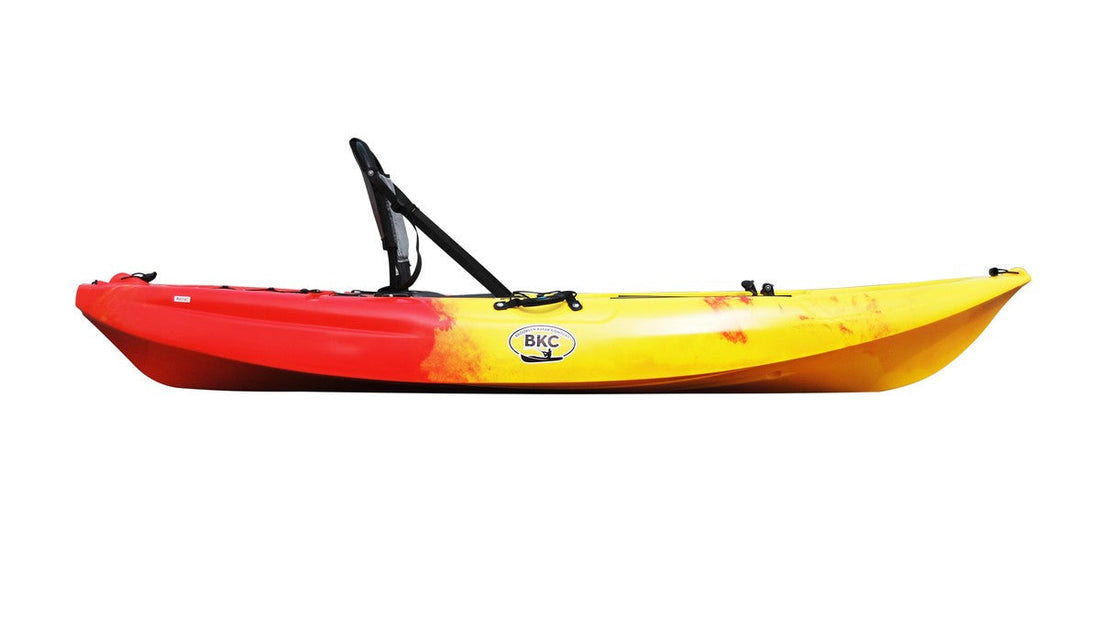When you first begin your kayak purchasing journey, you may think it is as simple as ‘pick one and go’. But there is a bit more to it than that! When you put the hull in the water, it is important to have the right hull for the job. Knowing a little bit about kayak hull design will go a long way toward an enjoyable kayaking experience.
Four Basic Kayak Hull Shapes
The hull is the frame or main body of a ship or boat. For a kayak, most of what you see is the hull. And the shape of the hull can have a big impact on the stability, speed, maneuverability, and trackability of your yak.

- V-Shaped Hull
If your primary goal in kayaking is to get from point A to point B as quickly as possible (a straight line, amirite?), then you might be interested in a v-shaped hull. The v-shape provides excellent tracking. With more of the hull pressed in by the water from the v-shape, it will maintain a straighter line. The same shape also cuts through the water cleanly to increase speed. Speaking of cutting, this shape can also withstand rougher waters because of its knife-likeness. However, a v-shape is likely to be more unstable than the other designs in calm water and at slower speeds.
- Round Hull
The round bottom seeks to remedy some of the issues of the v-shape. The round shape is extremely common because it is more maneuverable than the v-shape, but it can still maintain some speed, usually by being narrow in width to still maintain the “cutting through the water” property. But, it also handles adversity fairly well so rough water won’t send you packing like a wider flat hull might and calm water won’t tip you like a v-shape might.
- Flat Hull
Flat hulls are considered very stable as they sit right on top of the water. This hull is often found on longer, wider kayaks which make excellent stable platforms on top of the water, but it can also be used on short yaks as well. Flat bottom hull designs aren’t built for speed or trackability, so they are often seen as beginner hulls. But if your goal is playing on lakes and ponds, then this is the kayak hull design for you.
- Pontoon Hull
The pontoon hull is excellent for specialist activities, like kayak fishing, as it seeks to combine the advantage of v-shaped speed with flat/round hull stability. Pontoon (also known as tunnel) hulls have two “points” in the water. This means they can still cut through water to provide some speed, but they are also extremely stable for standing or sitting casting.
Chine Shapes
Another aspect of kayak hull design that can impact the stability of your vessel is the chine. The chine is the line where the sides and bottom of the hull meet.

- Hard Chine
If there is a clear delineation or edge where the bottom meets the side of the hull, you are looking at a hard chine. Creating this sharp edge allows the kayak to perform carving turns. But they are also likely to catch on debris and flip an unwary paddler.
- Soft Chine
The soft chine lacks the pronounced edge of the hard chine and allows the side to meld seamlessly into the bottom of the hull. The soft chine is considered better for beginners as they are less likely to flip, spin, or misdirect.
- Multiple Chine
This last type is often mistaken for a soft chine because it can be difficult to discern at first glance. The multiple chine attempts to get the best of both worlds by providing a bit of an edge for carving turns but a smooth side for less catching and flipping.
Rocker

Another kayak design feature to consider is the rocker. It might help to consider a rocking chair (or a banana). Is your kayak hull (from bow to stern) greatly curved or gently curved? If the edges of your kayak curve up and out of the water at the ends, you probably have a large (more) rocker. This design means that the kayak will bump against the waves less, which will decrease resistance and improve maneuverability. A gentler (less) rocker will allow more water contact which will improve tracking and speed.
Brooklyn Kayak Company can help you find the kayak for all your outdoor needs. Check out our extensive collection today.

